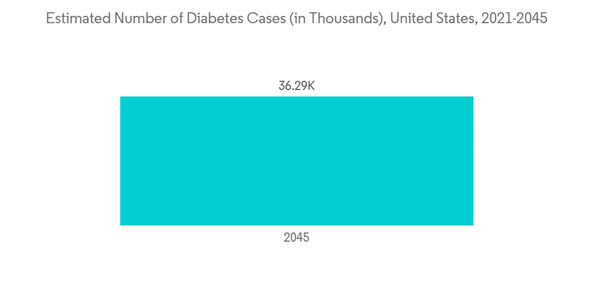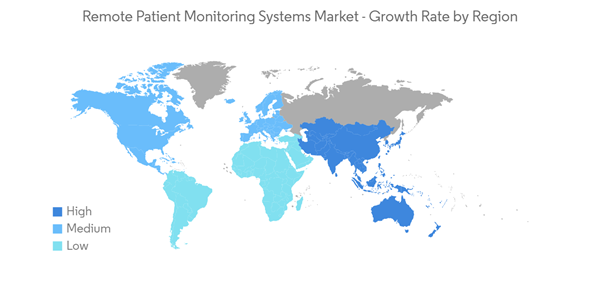The remote patient monitoring systems market is expected to register a CAGR of 8.54% during the forecast period.
The COVID-19 pandemic placed enormous pressure on hospitals and healthcare systems that were understaffed and overworked globally. Remote patient monitoring technology helped patients remain safe within their homes while reducing stress on hospitals, emergency rooms, and front-line healthcare workers during the pandemic, thereby positively impacting the market. The USFDA established a new regulation allowing healthcare practitioners to use FDA-approved Remote Patient Monitoring (RPM) devices to assess patients' body temperature, respiration rate, heart rate, and blood pressure without invasive procedures. COVID-19 has provided a strong foundation for clinicians and patients to use RPM effectively. According to a report published in NPJ Digital Medicine in 2021 by Jordan D. Coffey, the RPM technology engagement rate was 78.9% throughout the pandemic. The market studied was positively impacted by the high utilization of RPM devices during the pandemic. Currently, the market has reached a pre-pandemic status in terms of demand for RPM devices. However, it is expected to witness strong growth in the coming years.
The major factors driving the market include the rising burden of chronic diseases due to lifestyle changes, the surge in the geriatric population, and the growing demand for home-based monitoring devices. Remote patient monitoring is ambulatory healthcare that allows patients to use a mobile medical device to accomplish a routine test and guide the test data to a healthcare expert in real time.
Globally, the rising chronic disease population, the increasing aging population, and the demand for home-based monitoring devices are boosting the market's growth. For instance, according to the American Cancer Society's annual report published in 2022, an estimated number of new cancer cases in the United States was believed to reach around 1.9 million, and over half a million people were expected to die due to cancer in the country. Owing to the high expected incidence of cancer and the high mortality, there will be growing use of monitoring devices to track health among the affected population. Hence, the market studied will be witnessing a strong growth due to the rising chronic diseases such as cancer.
In addition, these devices are compact and portable, and patients can wear them all day without feeling uneasy. These devices also ensure that the patient’s condition is monitored continuously. Growing demand for home-based monitoring devices also boosts the market's growth. According to the Center for Medicare and Medicaid Services in 2021, remote monitors help several high-risk patients avoid being readmitted to the hospital and make the most of their healthy days at home. Clients who use remote monitoring report a 76% reduction in readmission rates, an average of 89% patient satisfaction, and a total medical cost savings of nearly USD 370 million.
However, healthcare industry professionals' resistance to adopting monitoring systems, a need for proper reimbursement policies in developed markets, and the stringent regulatory framework impede the market's growth.
The market players adopted various strategies, such as product launches, product developments, collaborations, and expansions, to increase their market share. For instance, in April 2022, Singapore brand BUZUD, Fosun Trade Medical Device, launched two new medical devices, namely the BUZUD Multi-Parameter Monitor (MPM), designed to streamline the medical monitoring process and help healthcare professionals provide a higher level of care to their patients, and the BUZUD PulseBit EX, a personal electrocardiogram (ECG) tracker that makes heart care affordable and convenient for heart patients. Such launches are expected to propel the growth of the market segment.
Therefore, the rising focus on a healthy lifestyle, increasing concerns about the constant monitoring of patients' health parameters, and the growing trend of self-monitoring and preventive medicine are expected to drive the growth of the overall market segment.
New product launches are a major factor contributing significantly to the market growth in the North American region. For instance, in May 2022, Novant Health launched a remote patient monitoring system in partnership with Health Recovery Solutions. The partnership was launched with a pilot program focused on bariatric patients, with plans to expand to other patient populations in the coming years.
Furthermore, the market players in the country adopted various strategies such as product launches, product developments, collaborations, and expansions to increase their market share. For instance, in October 2022, DocGo, a leading provider of last-mile mobile health services, announced that it would build upon its existing partnership with Gary and Mary West PACE and introduce a revolutionary remote patient monitoring (RPM) solution in the United States. In addition, in July 2022, Switzerland-based medical technology company Sleepiz registered its Sleepiz One+ contactless respiration and heart rate measuring device with the United States Food and Drug Administration (FDA). The FDA listing paved the way for Sleepiz to offer its solution for remote patient monitoring and clinical trials in the United States.
Therefore, the North American region is expected to register growth over the forecast period due to the abovementioned factors.
This product will be delivered within 2 business days.
The COVID-19 pandemic placed enormous pressure on hospitals and healthcare systems that were understaffed and overworked globally. Remote patient monitoring technology helped patients remain safe within their homes while reducing stress on hospitals, emergency rooms, and front-line healthcare workers during the pandemic, thereby positively impacting the market. The USFDA established a new regulation allowing healthcare practitioners to use FDA-approved Remote Patient Monitoring (RPM) devices to assess patients' body temperature, respiration rate, heart rate, and blood pressure without invasive procedures. COVID-19 has provided a strong foundation for clinicians and patients to use RPM effectively. According to a report published in NPJ Digital Medicine in 2021 by Jordan D. Coffey, the RPM technology engagement rate was 78.9% throughout the pandemic. The market studied was positively impacted by the high utilization of RPM devices during the pandemic. Currently, the market has reached a pre-pandemic status in terms of demand for RPM devices. However, it is expected to witness strong growth in the coming years.
The major factors driving the market include the rising burden of chronic diseases due to lifestyle changes, the surge in the geriatric population, and the growing demand for home-based monitoring devices. Remote patient monitoring is ambulatory healthcare that allows patients to use a mobile medical device to accomplish a routine test and guide the test data to a healthcare expert in real time.
Globally, the rising chronic disease population, the increasing aging population, and the demand for home-based monitoring devices are boosting the market's growth. For instance, according to the American Cancer Society's annual report published in 2022, an estimated number of new cancer cases in the United States was believed to reach around 1.9 million, and over half a million people were expected to die due to cancer in the country. Owing to the high expected incidence of cancer and the high mortality, there will be growing use of monitoring devices to track health among the affected population. Hence, the market studied will be witnessing a strong growth due to the rising chronic diseases such as cancer.
In addition, these devices are compact and portable, and patients can wear them all day without feeling uneasy. These devices also ensure that the patient’s condition is monitored continuously. Growing demand for home-based monitoring devices also boosts the market's growth. According to the Center for Medicare and Medicaid Services in 2021, remote monitors help several high-risk patients avoid being readmitted to the hospital and make the most of their healthy days at home. Clients who use remote monitoring report a 76% reduction in readmission rates, an average of 89% patient satisfaction, and a total medical cost savings of nearly USD 370 million.
However, healthcare industry professionals' resistance to adopting monitoring systems, a need for proper reimbursement policies in developed markets, and the stringent regulatory framework impede the market's growth.
Remote Patient Monitoring Systems Market Trends
The Multi-parameter Monitors Segment is Expected to Register Significant Growth over the Forecast Period
Multi-parameter monitors are devices with a single device that monitors various parameters, such as arterial blood pressure, heart rate, body and skin temperature, oximetry, and capnography. These devices have become popular as they are small, portable, and user-friendly. These multi-parameter remote monitoring devices are used by medical professionals and the health-conscious population, as sleep and activity monitors fall into these categories. The increased death rate due to chronic diseases across developed countries, such as the United States, and developing countries, has raised awareness among the patient population to opt for early and easy-to-monitor devices.The market players adopted various strategies, such as product launches, product developments, collaborations, and expansions, to increase their market share. For instance, in April 2022, Singapore brand BUZUD, Fosun Trade Medical Device, launched two new medical devices, namely the BUZUD Multi-Parameter Monitor (MPM), designed to streamline the medical monitoring process and help healthcare professionals provide a higher level of care to their patients, and the BUZUD PulseBit EX, a personal electrocardiogram (ECG) tracker that makes heart care affordable and convenient for heart patients. Such launches are expected to propel the growth of the market segment.
Therefore, the rising focus on a healthy lifestyle, increasing concerns about the constant monitoring of patients' health parameters, and the growing trend of self-monitoring and preventive medicine are expected to drive the growth of the overall market segment.
North America is Expected to be the Major Contributor to the Market over the Forecast Period
The major factors driving the market's growth include the growing burden of chronic diseases, an increasing geriatric population, demand for wireless and portable systems, and a sophisticated reimbursement structure.New product launches are a major factor contributing significantly to the market growth in the North American region. For instance, in May 2022, Novant Health launched a remote patient monitoring system in partnership with Health Recovery Solutions. The partnership was launched with a pilot program focused on bariatric patients, with plans to expand to other patient populations in the coming years.
Furthermore, the market players in the country adopted various strategies such as product launches, product developments, collaborations, and expansions to increase their market share. For instance, in October 2022, DocGo, a leading provider of last-mile mobile health services, announced that it would build upon its existing partnership with Gary and Mary West PACE and introduce a revolutionary remote patient monitoring (RPM) solution in the United States. In addition, in July 2022, Switzerland-based medical technology company Sleepiz registered its Sleepiz One+ contactless respiration and heart rate measuring device with the United States Food and Drug Administration (FDA). The FDA listing paved the way for Sleepiz to offer its solution for remote patient monitoring and clinical trials in the United States.
Therefore, the North American region is expected to register growth over the forecast period due to the abovementioned factors.
Remote Patient Monitoring Systems Market Competitor Analysis
The remote patient monitoring systems market is moderately fragmented. Various medical device manufacturers and several specialized remote patient monitoring equipment manufacturers are operating in the market. The industry is highly competitive, and there is a growing trend of partnerships and agreements between industry participants and other medical device manufacturers to incorporate remote patient monitoring functionalities. Some key market players include Abbott Laboratories, Aerotel Medical Systems, AMD Global Telemedicine, Baxter International Inc., Boston Scientific Corporation, GE Healthcare, Masimo Corporation, Medtronic PLC, F. Hoffmann-La Roche AG, and Omron Corporation.Additional benefits of purchasing the report:
- The market estimate (ME) sheet in Excel format
- 3 months of analyst support
This product will be delivered within 2 business days.
Table of Contents
1 INTRODUCTION
4 MARKET DYNAMICS
5 MARKET SEGMENTATION
6 COMPETITIVE LANDSCAPE
Companies Mentioned (Partial List)
A selection of companies mentioned in this report includes, but is not limited to:
- Abbott Laboratories
- Aerotel Medical Systems
- AMD Global Telemedicine
- Baxter International Inc.
- Boston Scientific Corporation
- GE Healthcare
- Masimo Corporation
- Medtronic PLC
- Omron Corporation
- Philips Healthcare
- OSI Systems Inc.
- Dragerwerk AG & Co. KGaA
- Compumedics Limited
- Nihon Kohden Corporation
- F. Hoffmann-La Roche AG
Methodology

LOADING...










